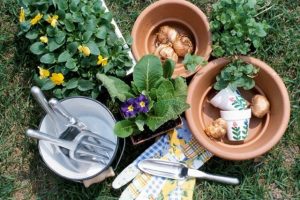Interesting terra cotta pots have an aged patina from years of use. You can achieve the same look in a matter of months using a few ingredients found in your kitchen and garden. With the holiday gift giving season approaching, consider “aging” a few terra cotta pots and filling them with cuttings from your garden or store-bought plants to give to family and friends. Here are four unique ways to “age” terra cotta pots.
The first simple process may take the longest time to achieve the desired results. Place the pot in a tub of water in full sun. Algae will eventually grow on the pot’s surface. Keep in full sun and replenish water as needed. The pot is “done” when you decide the surface has the aged look you desire.
For a more “earthy” look use the soil method, a fun technique for the kids. Rub the surface of the pot with soil that has been moistened with a little water. Our foothills clay soil works really well with this method of “aging.” Once coated with soil, place the pot in a shaded area for at least one month while the soil bonds. To create a more varied, textured surface, brush the pot with a flexible wire brush.
Next, we have the yogurt method. Using plain yogurt and a foam brush, coat the surface of the pot completely. Yogurt applied to a dry pot yields a more dramatic look than if you soak the pot in water for 15 minutes before applying the yogurt. Once coated, place the pot in a shaded area for at least one month or until you like the look.
The last technique uses buttermilk and moss. The moss holds the runny buttermilk in place and varies the texture to promote growth. You can use sheet moss or gather moss from your garden. If you use gathered moss, remove much of the soil as possible and any debris in the moss. Tear moss into small pieces and combine with buttermilk in a small bowl. Use a foam brush to paint mixture over the entire pot. Place in a shaded spot until you like the look of the pot. Use a metal brush to remove heavy clumps of moss if desired.
Each technique gives a different look, but a few common tips apply to all methods:
Ingredients: It’s fine to use expired dairy products. Higher-fat-content products tend to be thicker and less likely to drip off.
Application: Vary the thickness of the materials and the direction of application.
Storage sites: Shaded locations are ideal for most pots while they “age.” Don’t stack pots inside each other. Spray them occasionally with water or place them where rain can reach them. Pots coated with food products may have an odor for a few days.
Waiting: The longer a pot sits the more pronounced the effect will be.
Be creative. Combining methods on one pot can lead to some unusual and interesting effects. Have fun!
Carolee James is a former University of California Cooperative Extension Master Gardener of Tuolumne County who believes every garden should have a few ‘aged’ pots about the garden as they lend an air of maturity and stability to the space.

